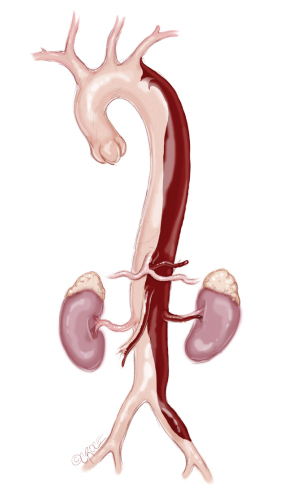Marfan Syndrome
Background
Marfan syndrome is a genetic disorder that affects connective tissue in the body. This disorder can be inherited from an affected parent or may occur through a spontaneous genetic mutation. Connective tissue is a necessary structural component in the body as it holds tissues and organs together and ensures normal growth and development. Since it is found throughout the body, many different organs can be affected by the disorder. These include the heart, blood vessels, eyes, lungs, bones, joints and skin. Some of these defects can lead to serious complications and may be life-threatening. Early diagnosis and treatment are necessary to prevent these complications and ensure a good quality of life for those affected.
Signs and Symptoms
Marfan syndrome affects approximately 1 in 5,000 people, and includes men and women of all ethnic groups. The signs and symptoms manifests differently between individuals, and can take many years to develop. Some features include tall stature, long fingers, flexible joints, or high arched palates. Patients may also have heart murmurs and problems with vision, such as extreme near-sightedness. Marfan syndrome is usually diagnosed on clinical grounds, although additional imaging and genetics tests can also be helpful. As there is significant variability between signs and symptoms in different patients, it is recommended to seek advice from your doctor if you are concerned.
Cardiovascular Complications
Complications involving the heart and blood vessels may be serious. A significant area where connective tissue may be weakened is in the wall of the aorta, the large artery that exits the heart to supply blood to the rest of the body. With high blood pressure, this may cause an abnormal bulge in the wall of the aorta, causing an aortic aneurysm. A sufficiently large aneurysm will require surgical intervention to minimize the risks of rupture. Additionally, a tear in the wall of the aorta may develop and cause an aortic dissection, where blood enters in between layers of the aortic wall. If this occurs, patients will experience severe chest pain, which can sometimes spread to the shoulder blades. Surgical intervention is required urgently, as otherwise the risks of death is very significant. The risks of cardiovascular complications are even greater during pregnancy, where the heart is pumping more blood than normal and putting more pressure on the aorta. These issues must be thoroughly discussed with your doctor and managed.
Management
Management aims to prevent the various complications of this condition. Medications to lower blood pressure are often used to decrease stress on the wall of the aorta. Other non-surgical measures include glasses or contact lenses for nearsightedness and a back brace for some children and adolescents with scoliosis. Surgery may be necessary to repair the aorta if it becomes too enlarged or if a dissection occurs. This involves replacing the portion of enlarged or dissected aorta with a synthetic tube. Surgery may also be necessary to replace a faulty heart valve or to repair eye abnormalities, such as retinal detachments or cataracts. Regular monitoring is key to the early detection, prevention and treatment of complications.
For more information, please visit the following websites:
http://www.marfan.org/about/marfan
http://www.nhs.uk/conditions/Marfan-syndrome
http://emedicine.medscape.com/article/1258926-overview

Services
Cardiac Surgery
- Aortic Arch Surgery
- Aortic Stenosis
- Aortic Surgery and Stroke
- Aortic Valve Repair
- Coronary Artery Bypass Grafting
- Heart Failure
- Tissue and Mechanical Heart Valves
- Type B Aortic Dissection
- Ventricular Assist Devices
- Hybrid Aortic Arch Surgery
- Marfan Syndrome
- Minimally Invasive Aortic Valve Replacement
- Minimally Invasive Atrial Fibrillation Surgery
- Minimally Invasive Mitral Valve Surgery 2015
